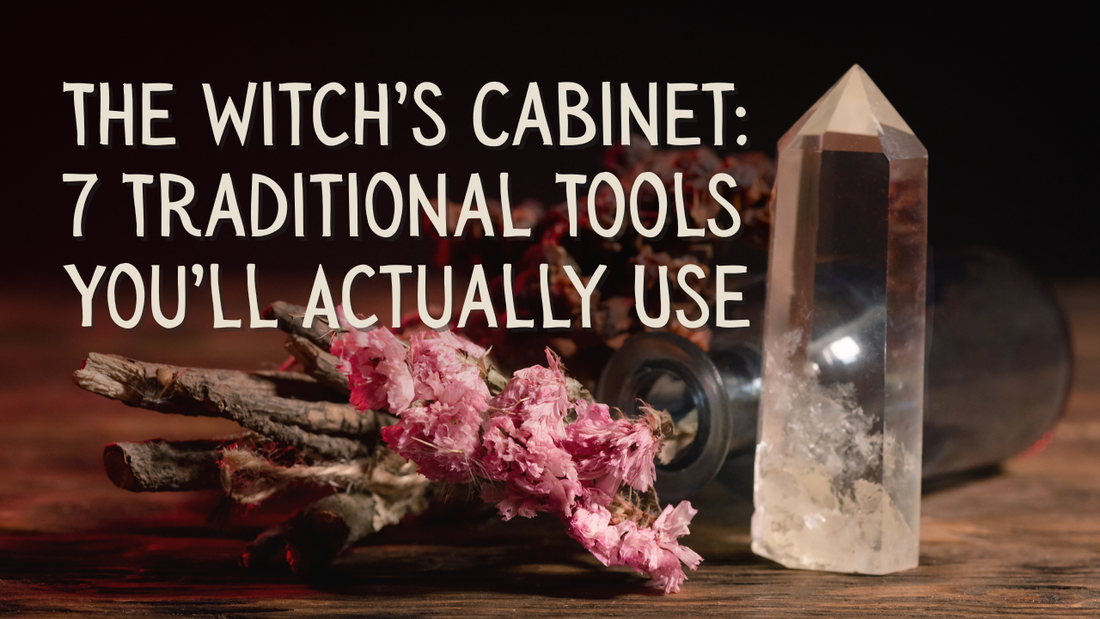If you’ve ever googled “witchcraft tools” and ended up overwhelmed by lists with 42 different crystal wands and moon-shaped chalices, you’re not alone. But here’s the thing: most traditional witches — especially those practicing folk magic — didn’t own anything fancy.
The old witch’s cabinet was simple, practical, and made up of tools used often and with intention. In this post, we’ll walk through seven useful items that actually earn their place on your altar or tucked into your cabinet.
1. The Knife (or Blade)
Often called a boline or seax in some traditions, a small knife was one of the most practical tools. Not for ritual theatrics, but for real work — cutting herbs, inscribing candles, or carving charms into wood or bone.
- Keep one knife for herbal use only - especially if you work with poisonous plants.
- A curved blade is traditional, but use what feels right.
- "Never use it for food" — a bit of a Wiccan rhetoric, a folk practitioner may not subscribe to. But please do clean your blade if you are using it for a multitude of things.
2. Feather or Smoke Fan
In folk magic, smoke plays a big role — cleansing a home, blessing a charm, or marking sacred space. A feather bundle or hand fan helps direct the smoke.
- Goose, crow, or rooster feathers were often used.
- You can craft your own from ethically found feathers (though in the US some states prohibit this).
- Use with incense, herb bundles, or a small cauldron.
3. Fireproof Dish or Cauldron
You don’t need a giant cast iron pot — just something fire-safe to burn things in.
- Ideal for loose incense, petitions, herbs.
- Can also hold water or salt when needed.
- Bonus if it’s small enough to travel with.
4. Herb Bundles
Herbs are the backbone of most folk magic traditions. Whether you’re burning, steeping, or stuffing them into a charm bag, they belong in every cabinet.
- Mugwort, yarrow, rosemary, and wormwood are essentials.
- You can gather and dry your own or buy them pre-bundled.
- Always label your herbs (especially the nightshades!).
→ Browse dried plants and spell bundles in our Apothecary section.
5. Bone, Tooth, or Claw
In old witchcraft, animal parts were never just decoration — they carried the spirit and energy of the creature, used for protection, cursing, and spirit work.
- A fox tooth for cunning, crow bones for insight, deer antler for strength.
- Ethically sourced or found pieces only — always with respect.
- Cleanse bones with salt; or use smoke & moonlight instead.
→ Our Curiosities section includes claws, antlers, and other ethically sourced items.
6. A Crystal or Stone That’s Actually Useful
Forget the endless lists. Choose 1–2 stones you connect with and learn to use them well.
- Obsidian: for protection and truth-telling
- Quartz: for amplifying your spells
- Jet or smoky quartz: for grief, grounding, and hex work
→ Not sure what to choose? Browse our Crystal section.
7. The Book (Your Book)
Whether you call it a grimoire, a journal, or a working book — start one. It doesn’t need to be perfect. It just needs to be yours.
- Record plant lore, dreams, divinations, and charms.
- Include what works (and what doesn’t).
- Think of it as your legacy — something that grows with you.
FAQs: The Witch’s Tools
Do I need everything on this list?
Nope! Start with what’s calling to you. One knife and a bundle of mugwort can take you far.
What about a wand, chalice, or athame?
If they’re meaningful to you, use them. But many folk witches never touched a wand in their life.
Can I use vintage or secondhand tools?
Absolutely — just cleanse and dedicate them. We love repurposing antique items with a bit of history.
Final Thoughts
You don’t need a whole room of witchy gear to work real magic. Start with the tools that speak to your practice — simple, functional, and full of history.
Explore our curated selection of handmade and vintage tools in the Witchcraft Tools collection.

